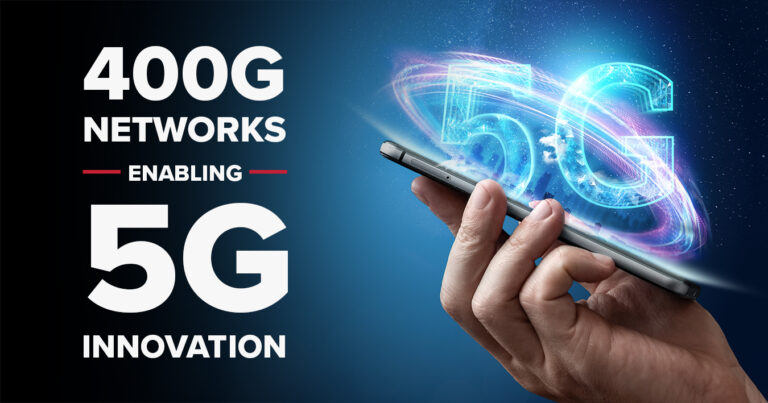
400G Networks: The Foundation for 5G Innovation

The era of 5G is finally here. On August 4, 2020, T-Mobile powered up the first ever standalone nationwide 5G network in the US. The company’s President of Technology, Neville Ray, referred to it as a “massive step into the future” and a key step in “opening the door for massive innovation in [the US].” Of course, T-Mobile isn’t the first with a rollout. AT&T and Verizon have each been working on their own 5G coverage for the past few years.
Yet, the shift to 5G isn’t just about deploying small cells as close to end-users as possible – a part of our modern edge computing paradigm. It will also involve a widespread shift to 400G networking on the part of mobile service providers, MSOs, data center operators, carriers and anyone else involved in making the promises of 5G a reality.
5G, the Edge and Real-World Applications
The 5G wireless standard will offer speeds, latencies and a connection density superior to anything 4G has achieved. Check out this comparison table below:
| 4G LTE | 5G | |
| Peak Data Rate | 150 Mb/s | 10 Gb/s |
| Latency | 50ms | 1 ms |
| Connection Density | 2,000 / square kilometer | 100,000 / square kilometer |
Comparison of 4G LTE and 5G technologies available here.
As Network World notes, “once an industry gets ‘on-net’ and becomes both smart and connected, the innovations accelerate, driving even more demand onto the network.” It’s pretty clear that 5G’s metrics offer a lot of potential for the greater proliferation of new technologies such as autonomous vehicles, smart cities, consumer and industrial IoT, UHD (4K and 8K) streaming and virtual/augmented reality.
A standard like 5G, however, is only as good as the network architecture it relies on. All the new technologies businesses and consumers are eager to leverage with 5G require extremely low latency connections between devices, small cells, data centers and the cloud. As a result, the edge computing paradigm’s emphasis on location is paramount. As ZDnet notes, “where you can reduce the distance, the speed of electrons being essentially constant, you minimize latency.”
By relying on edge architectures, 5G demands not only greater fiber densification at the edge, but also significantly higher data rates on existing fiber networks. That is where 400G comes in, offering carriers, MSOs, data center operators and other service providers the ability to future-proof their networks for all 5G demands, and more.
Attractiveness of 400G networks
With demand for data-intensive services only continuing to skyrocket, the need for increased data rates continues to mount. Whereas 100G and even 200G used to be considered an advanced upgrade, network operators in multiple sectors are seeing the value of investing in 400G. One of 400G’s biggest value propositions is that it offers better potential to accommodate future jumps to 800G and beyond. It really is an investment in the future of optical networks.
Certainly, the need to make leaps is already upon the optical networking industry. In fact, Network World recently reported that, by 2022, 5 zettabytes of IP traffic will be generated globally per year. As a result, network operators are beginning to increase their investments in optical transceivers capable of delivering 400G data rates. See this graph of 100G, 200G and 400G transceiver revenue from 2018 to 2024, which utilizes data from Ovum.

As the data demonstrates, 100G and 200G transceivers will still be popular through 2022, but thereafter through 2024, 400G will account for an ever-increasing share of the revenue earned by all three transceiver product families. Considering how many devices 5G can support within a square kilometer and how the applications running on those devices need low latency communication between multiple traffic exchange and data processing points, investing in 400G makes a lot of business sense.
The IEEE formally approved a 400G standard in 2017 and different equipment manufacturers are working on different technologies for achieving 400G in a cost-effective way. Of course, not all methods of achieving 400G are the same. For MSOs, carriers, data center operators and other providers, the trick is to acquire more throughput with less. Unfortunately, the existing 4X25G 100G implementation presents an impediment as it requires additional equipment, space and power to get networks up to the 400G standard. On the other hand, single lambda 100G offers one of the most cost-effective ways to enable more traffic to flow across modern networks.
Precision OT Supports 400G
At Precision OT, we’re big proponents of single lambda 100G as using four lines of 100G and PAM4 modulation can enable network operators to achieve the 400G data rates they need to support 5G and its edge architecture. We are now offering four different 400G transceiver variants in the QSFP-DD form factor, along with various 400G AOC and DAC offerings. We have plans to continue innovating and creating more 400G optical equipment solutions for our customers – stay tuned for more!
As Chris Page, our CTO, says, “It is about creating networking solutions that grow over time and accommodate increased demand cost-effectively, with both flexibility and agility.” Ask us about our 400G transceivers today!






